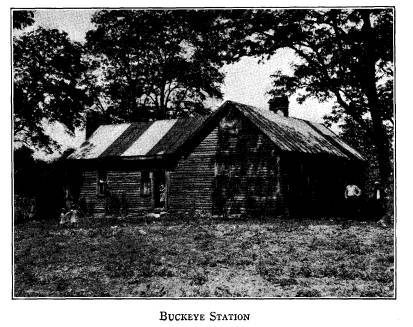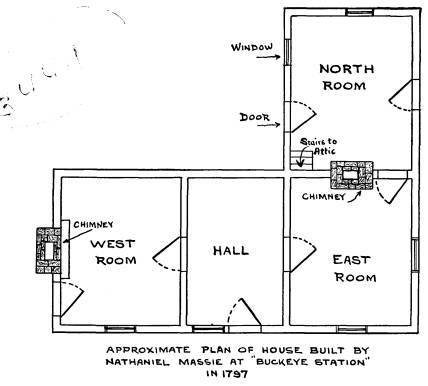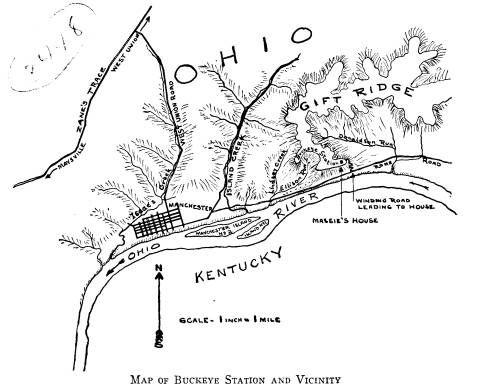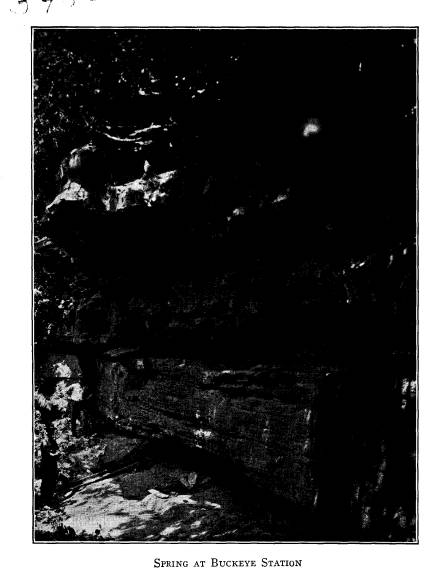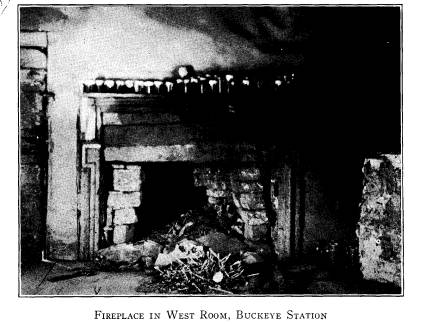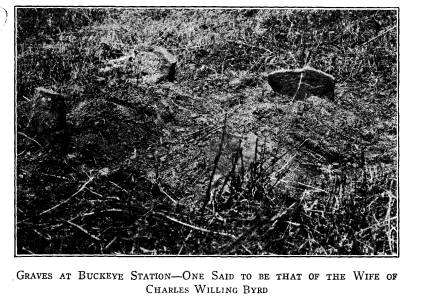Ohio History Journal
- 1
- 2
- 3
- 4
- 5
- 6
- 7
- 8
- 9
- 10
- 11
- 12
- 13
- 14
- 15
- 16
- 17
- 18
- 19
- 20
- 21
- 22
OHIO
Archaeological and Historical
PUBLICATINOS
BUCKEYE STATION
BUILT BY NATHANIEL MASSIE IN 1797
BY MORTEN CARLISLE
Shrouded in the mists of obscurity and
but little
known except to a few of the older
generation in and
about Manchester, Ohio, this old house,
built by the
famous surveyor, General Nathaniel
Massie, stands to-
day, mute evidence of the excellence of
his work and a
link between the throbbing life of the
present day and
those hardy pioneers, whose toil and
suffering made
possible the settling of the Northwest
Territory and the
making of our great State of Ohio.
This house, built in 1797, on the high
hill overlook-
ing the Ohio River, is possibly the
oldest existing dwell-
ing in Ohio, with the exception of one
or two houses in
Marietta. It was probably the first
attempt of Nathan-
iel Massie to make for himself a
permanent home, but
at that he had but little time to enjoy
such a home, for,
aside from being still unmarried, he
was an unusually
busy man, with many projects under way,
notably the
|
2 Ohio Arch. and Hist. Society Publications establishing of Chillicothe, which he undertook in 1796, so that he had few opportunities for enjoying the com- forts of life. A man of great vision, the son of Nathaniel Massie, Sr., of Goochland County, Virginia, on the upper James River, he had come out to Kentucky in 1783, not as a |
|
|
|
penniless soldier of fortune, but to take up lands which had already been located by Daniel Boone for the elder Massie. These lands were given to his son and he was also given an outfit and some capital. Others in Vir- ginia commissioned him to locate land for them, so he came out with a definite object in view and the means for carrying out his projects. |
Buckeye Station 3
Massie was young and active, at the age
of twenty
years, and with the full flush of
manhood in his veins
he set to work vigorously. He learned surveying
rapidly, was for a time a deputy
surveyor under Rich-
ard Clough Anderson, the principal
surveyor of Vir-
ginia lands, who opened an office in
Louisville in 1784.
No survey was legal unless made by
Anderson or one
of his deputies, so that Massie had
this advantage, in
addition to his natural ability. He was
an unusually
good judge of distances and the lay of
the land, so that
his surveys soon became recognized as
more accurate
than those made by others and he was
commissioned to
do a great deal of locating.
He rapidly accumulated property and was
well-to-do
when in 1790 he decided to undertake
the establishing
of a settlement on the Virginia
military lands on the
north side of the Ohio River. In August
1790 the
Congress of the United States had
passed the act au-
thorizing the locating of military land
claims within the
limits of the Virginia Reservation,
between the Scioto
and Little Miami Rivers, north of the
Ohio River.
There was immediately a rush of those
who held land
warrants to secure the best land within
those bound-
aries. Massie, being by this time an
experienced woods-
man and of great courage, was
commissioned to locate
many of these claims. The usual fee was
fifty pounds,
or in lieu of money a twenty-five to
fifty per cent in-
terest or share in the amount of land
the warrants
called for. With such liberal
remuneration is it to be
wondered at that he soon became wealthy
and the owner
of a large amount of landed property?
|
4 Ohio Arch. and Hist. Society Publications The surveying of lands on the north of the Ohio River was a perilous undertaking and the surveyors had to go armed and with an armed guard as a protection against the attacks of bands of Indians. To make their escape across the river and to safety on the Kentucky |
|
|
|
shore was no easy matter for the surveyors and to pro- vide a base of operations and a refuge of safety Massie decided to establish a settlement and a stockaded fort on the north side of the Ohio. To this end he posted notices in the Kentucky settlements and otherwise ad- vertised his plan, which was to build his fort on the bot- |
Buckeye Station 5
tom land, opposite the lower end of
what is now known
as Manchester Island No. 2, but was
then known as the
lower of the three islands.
To any one agreeing to move to his
settlement he
made the following offer: "The
free gift of one in-lot,
one out-lot and 100 acres of farm land,
the in-lots to
measure 5 poles (82 1/2ft.) in width on
the front or street
side, and 11 poles (181 1/2ft.) in
depth. The out-lots to
consist each of four acres of bottom
land and the farms
to be of 100 acres located at a greater
distance from the
fort. But there was a condition
attached to this gift:
each man had to agree to reside for two
years in the set-
tlement. He could not leave for any
extended time
without supplying a male substitute to
aid in the pro-
tection of the fort in case of attack.
At the expiration
of the two years he was to receive
title to his property.
Many of the 100-acre farms were located
quite a
distance from Manchester, on what is
known as "GIFT
RIDGE," and which is marked on the accompanying map.
This ridge is a nearly level plateau,
about 500 feet above
the river level, and the probable
reason for giving the
settlers this land at such a distance
was on account of
its being better soil than that of the
narrow valleys.
The only really fine land was in the
river bottoms and
there was not sufficient of that to
supply all the settlers,
except at a too great distance from the
settlement, so
Massie evidently gave the best he
could, which happened
to be on what was afterwards named "GIFT
RIDGE" on
account of the free gift of the
property.
From
The Life of Nathaniel Massie by David
Meade Massie (grandson of Nathaniel
Massie) we
6 Ohio Arch. and Hist. Society
Publications
learn that the
following people signed the contract for
establishing the
settlement:
N. Massie John
Ellison
John Lindsey Ellen
Simmeral
William Wade John +
McCutcheon
John Block Andrew
+ Anderson
Samuel + Smith Matthew +
Hart
Jesse + Wethington Henry Nelson
Josiah Wade John
Peter C. Shanks
John Clark James
Allison
Robert Ellison Thomas
Stout
Zephaniah Wade George -
Wade
It will be noted that
only 20 names are on the list,
whereas it has been
stated by historians that Massie re-
quired 25 people to
join his company before beginning
work. Probably others
joined at a later date but the
above are all that
David Meade Massie gives in his ac-
count. Six of these
"signed by mark."
Having secured the
desired number of settlers to ac-
company him, Massie
now began his life work in the
Northwest Territory.
Gathering their tools, household
goods and such
materials as they needed they crossed
the river and set to
work constructing the stockade,
about opposite the
lower end of the lower island, on the
Ohio side. By March
1791 "Massie's Station" was
finished, so far as
the actual building of the cabins was
concerned and it was
enclosed by a stout stockade of
heavy log pickets set
in the earth, and bound together
at the top. The
settlers were busily engaged in clearing
the out-lots, to
prepare them for cultivation. After Gen-
eral St. Clair's
disastrous defeat on November 4, 1791,
the Indians became
very bold and caused much loss and
suffering among the
scattered settlements of the North-
|
Buckeye Station 7 west and in Kentucky. Massie's Station, however was not attacked, but some of his men were captured outside of the fortification, notably Israel Donalson, a member of one of his surveying parties, and also Andrew |
|
|
|
Ellison, both of whom eventually returned safely after many hardships. The most tragic event was the killing of Asahel Edgington on Lick Creek about five miles northeast of where West Union now stands, and very near where the Treber Tavern was afterwards built. The name of Massie's Station was later changed to NOTE. Donaldson's Run in the above map should be Donalson Run. |
8
Ohio Arch. and Hist. Society Publications
MANCHESTER, being named after
Manchester, England,
the original home of the Massie family.
In his exploring about the country
adjacent to Man-
chester, Massie had been impressed with
a certain spot
on the top of one of the hills a few
miles east of his set-
tlement, which had a magnificent view
of the river in
both directions, was nearly level, had
many fine springs
of water and was an unusually
attractive place. A
reference to the map will show its location.
He re-
served this tract for his own use,
eventually building a
cabin of buckeye logs on one end of the
plateau. He
probably intended to use it as a summer
home, or pos-
sibly to escape the effects of the
malaria which was so
prevalent on the low lands, but he left
no mention of it
among his papers, so far as I can find,
nor is it men-
tioned in any of the accounts of
Massie's life. How-
ever it evidently did occupy a
prominent place in his
thoughts and he may have made
considerable use of it at
times. Undoubtedly it was of more than
a passing
whim with him, for Captain Nelson W.
Evans, in his
excellent History of Adams County, published
in 1900,
has this to say of Buckeye Station,
which we will quote
verbatim:
"THE OLDEST HOUSE IN OHIO"
"Four miles above Manchester, on
the Ohio River,
there is a spot whose natural beauty
attracted the ad-
miration of the untutored savages, long
before they ever
met the white men. There they visited
and maintained
an outlook up and down the river. There
they buried
their dead, whose graves are known to
this day.
"General Nathaniel Massie visited
this place in 1791
and so delighted was he that he
proceeded to locate it as
Buckeye Station 9
his own. ..A high, almost level
plateau, between the val-
leys of Donalson's Run on the east and
Ellison's Run
on the west, connecting on the north
with "GIFT
RIDGE." The south-east corner of
this plateau affords
a magnificent view of the Ohio River
for many miles in
either direction. Massie first built a
cabin of buckeye
logs and called the place "BUCKEYE
STATION." In order
to render his choice location secure
from attacks of In-
dians, he took up the entire GIFT RIDGE,
to the north of
it for four or five miles with military
warrants and gave
the land to those who would settle on
it and thus placed
a cordon between himself and the
savages. Massie was
a brave man but he liked company when
Indians were
expected.
"So captivated was he with this
place that notwith-
standing the fact that he laid out
Chillicothe in 1796 and
had taken up a fine piece of land on
Paint Creek, in what
is now Ross County, in 1797, in the
summer of 1797 he
proceeded to erect a frame house where
the Buckeye
cabin had stood. This was at a time
when a frame
house was a remarkable undertaking. All
lumber had
to be sawed by hand, 'whip-sawed' as it
was called.
"The house, still standing, is
about ten rods (165
feet) back from the cliff on the south,
overlooking the
Ohio River and five rods (52 1/2 feet)
from the bluffs on
the east overlooking Donalson's creek,
where on April
22nd 1791 Israel Donalson was captured
by a band of
Indians. All timbers and boards had to
be sawed by
hand with whip saws and all nails were
made by hand
by a blacksmith on an anvil. The house
is but one story
high but has two very fine chimneys,
one single and one
double. Those chimneys were built most
substantially.
|
|
|
(10) |
Buckeye Station 11
They stand today, (1900) as perfect as
when, one hun-
dred and three years ago, they were
erected.
"The house fronts to the south,
with a side front to
the east, looking up the Ohio River,
and with a further
room to the north, making two rooms on
the east side
of the house. Between these two rooms
is the great
double chimney. To the west is a wing
with a hall and
one large room with the other stone
chimney at the
west end. The hall fronts to the south
and on each
side of the door is a window to enable
the inmates to in-
spect the guest before entering.
"From the hall is a door on each
side for entering
the east and west rooms. Entering the
east room we
find a window to the south and one on
the east side,
both with very small panes of glass.
Walls are lined
with very wide boards, the ceiling is
plastered. Floors
are of old fashioned boards, such as
are no longer seen.
The fireplace in the east room is a
feature, it being four
feet high from hearth to the arch and
eight feet in width.
Entering the north room we find a door
and window
to the east and a door and window to
the west. On the
right of the chimney, in the north room
was a stair-
way leading to two attic rooms, which
were sided and
ceiled with boards, these attic rooms
being over the
north and south rooms only.
"The west room had the single
stone chimney and
over it an old fashioned wooden mantel
of walnut,
carved and figured, which was the pride
of the owner
and the envy of the neighbors.
"The floor boards, though very
wide, were tongued
and grooved, and the weather boards, on
the outside of
the house, were put on pointed instead
of overlapped.
|
12 Ohio Arch. and Hist. Society Publications The house may have had other additions to it but they were gone when we visited it in 1900. "The grounds about the house had at one time been tastefully laid out and traces of such were still evident. Two locust trees stand in front of the house to the south, at least ten feet in circumference (about 3 ft. |
|
|
|
diameter) and not less than 100 years old. Northwest of the house about ten yards stands an enormous cherry tree 13 feet 6 inches in circumference (about 4 ft. diameter). "Approaching over a very bad road, up and down hill, over stones and boulders, two miles from GIFT RIDGE, which difficulty of access has to a certain ex- tent isolated the house and kept the curious from de- |
Buckeye Station 13
stroying it, which would have been the
case if it had
been on a well travelled road, but
being so difficult to
reach has been its preservation. Seven
fine springs flow
from the hillsides near the residence.
"At this place General Nathaniel
Massie dwelt oc-
casionally from 1797 to 1802, but the
shades of ob-
livion are so fast darkening the
history of this hardy
pioneer that but little can be learned
of his residence
there during that period. General
Massie's wife was
Susan Meade, the daughter of Colonel
David Meade,
of Maycox, Prince George County,
Virginia. Colonel
Meade had moved out to Kentucky and at
the time of
his daughter's marriage he resided at
his country estate
of Chaumiere des Prairies, near
Lexington. Mrs.
Massie's sister married Charles Willing
Byrd, Secre-
tary of the North-West Territory and
later appointed
U. S. District Judge for Ohio,
1803-1828. Judge Byrd
bought Buckeye Station consisting of
600 acres, from
his brother-in-law, Nathaniel Massie,
in 1807 for $3,100
and moved there in June, 1807. He was
then 37 years
old and his wife 32. His children were
MARY, POWELL,
KIDDER MEADE, WILLIAM SILONWEE, and EVELYN.
"Judge Byrd had been born and
reared at the
princely estate of Westover, seven
miles from Williams-
burg, Virginia. His wife was from
Maycox, a short
distance from Westover. Both he and his
wife had
been reared in all the luxury of the
times. From 1797
to 1807 they lived in Cincinnati, then
but a small village,
but the largest settlement in the
Northwest, and why
they chose to move to such a wilderness
no one can con-
jecture. Here Judge Byrd and his family
saw the first
steamboat descend the Ohio River in
1811 and here his
14
Ohio Arch. and Hist. Society Publications
patient wife died on the last day of
February 1815, and
was buried under a walnut tree about
200 yards from
the house. Her grave is still visible.
"After the death of his wife,
Judge Byrd moved to
West Union and sold the place to John
Ellison, son of
Andrew Ellison of Lick Fork, for
$4,000. John Ellison
resided here from 1818 to 1829, the
time of his death,
and here most of his children were
born. His wife was
Annie Barr, whose father, Samuel Barr had
been killed
in a fight between Kentuckians under
Simon Kenton
and a party of Indians under Tecumseh,
March 1792.
Sarah, the second child of John
Ellison, married the
late Thomas W. Means, of Hanging Rock,
Ohio. There
John Ellison's daughter, Mary K., was
married to Wil-
liam Ellison, her distant cousin and
there her sister
Esther married Hugh Means of Ashland,
Kentucky.
"Jane Ellison, another daughter,
was the wife of
David Sinton of Cincinnati. She was
born here, but
was married to Mr. Sinton at the home
of Thomas
Means, at Union Landing. She died in
Manchester in
1853 and was buried in the Presbyterian
churchyard
there. Her daughter is the wife of Mr.
Charles P. Taft,
of Cincinnati.
"Here also the late John Ellison,
a banker of Man-
chester, was born and here he spent a
happy childhood.
While the Ellisons resided here the
Station had many
distinguished visitors from Cincinnati,
Maysville,
Hanging Rock and elsewhere."
The above is the only account I have
been able to
find of Buckeye Station, but the facts
are so well
grounded in local traditions of the
neighborhood that
the statements are all probably true.
The house was
Buckeye Station 15
probably but little used by General
Massie for the
reason that his interests had been
transferred to his new
settlement of Chillicothe, and he may
have lived there
only during the summer months, before
his marriage,
or have used it as a base for hunting
expeditions, etc.
Massie was married in 1800, and he
built his fine
two-storied house near the "Falls
of Paint Creek" at
that time, so he really had only three
years in which he
could have made any use of the Buckeye
Station place.
So few people have actually visited the
Station that
on August 2, 1930 at the invitation of
the present
owner, Mr. Samuel Drennon Baldwin, of
Manchester,
the writer, accompanied by Mr. William
H. Burtner,
went to Manchester and thence to the
Station. The
road was as Captain Evans had described
it, rough,
steep and with large rocks over which
the automobile
had to climb. Mr. Baldwin had directed
us by way of
the Island Creek road to Cat-Bird
School, thence up
GIFT RIDGE to QUINN'S
CHAPEL, following the Ridge
south and through George Osman's farm
to the house.
From
Quinn's Chapel to the Station the route was
nearly level, but the road is too rough
to be recom-
mended.
Passing through several barnyards,
opening and
closing gates and chasing cattle out of
our way, we
finally came out on the "BUCKEYE STATION" property.
There are at present about 150 acres in
the farm. The
soil seems to be good, and the crops
were in better con-
dition than those of the valleys. The
top of the hills
is a plateau, with several feet of
loamy, friable soil,
overlying a heavy strata of stone,
which is said to be a
dolomite, that is, about forty per cent
magnesium car-
|
16 Ohio Arch. and Hist. Society Publications bonate and sixty per cent calcium carbonate, although it looks more like a brown sand stone. This strata is twenty to thirty feet thick; and as it is somewhat porous it acts as a retainer of water during the dry periods, feeding it out in the form of springs at the parting be- tween the lower and impervious shale and clay forma- |
|
|
|
tion. These springs were quite strong at the time of our visit, even though it was during the driest period in the history of the Ohio Valley. As you drive across the fields towards the house you suddenly come out on the bluff overlooking the river, and the road runs along close to the edge. Before reach- ing the house the road passes a remarkable projecting shelf of rock which extends out over the valley below for sixty or seventy feet. This is a bare rock devoid of |
Buckeye
Station 17
all vegetation and is
known locally as "HANGING ROCK"
but it must not be
confused with the town of Hanging
Rock, in Lawrence
County, this being a local name only.
From Hanging Rock you
obtain a wonderful view of
the valley with the
river about 500 feet below. The
river and the
Kentucky hills lie like a panorama, stretch-
ing out in endless
billows of green with the silver rib-
bon of water below
for fully ten miles in either direc-
tion. The break in
the hills where Ohio Brush Creek
makes its valley is
easily discernible to the East and
farther on you can
follow the line of hills almost to
Vanceburg, Kentucky.
To the west the view is ob-
structed to a certain
extent by the projecting foliage of
a large tree, but through
its leafy branches one can fol-
low the river for a
few miles below Manchester.
This rock is the
stone cap rock of the region, an
isolated piece which
has withstood the weathering ef-
fects of time. It
stands out with a sheer drop of 150
feet or more to the
hillside below. This is probably the
lookout used by the
Indians, and referred to by Cap-
tain Evans in his
description. It is the most striking
feature of the place
and a finer lookout would be hard
to find.
The location of the
house is substantially as de-
scribed in Evans'
account except it is in very bad repair,
filthy and dirty
beyond description. It is occupied by a
family of renters,
tenants of Mr. Baldwin. Many
changes have been
made within recent years. Mr.
Baldwin says that the
original weather-boarding has
been replaced, but it
does not look as if it had been re-
placed within many
years, as it is so old and dilapidated.
If it had been put on
within the last 30 years, which
Vol. XL-2.
|
18 Ohio Arch. and Hist. Society Publications would be since the time Captain Evans visited it, I do not think it could possibly have deteriorated so much. The boards are so old and weathered it would have taken more than 30 years to make them so. They look like the original covering and a reference to the photo- graph of the house will show them, warped, split and broken. These boards are lapped, similar to weather- |
|
|
|
boards of the present day, not pointed which I suppose Captain Evans meant for tongued and grooved. The weather-boards on Treber's Tavern, near West Union, which was built in 1798 are tongued and grooved, and I understand they are the original covering, in no worse condition than those on Buckeye Station. The large fire place has been torn out and the chim- ney walled up, with only a hole for a stove pipe left. We were particularly disappointed in this as we had hoped to see the original fire place with swinging crane, |
Buckeye Station 19
and other accessories. The north room
had another
opening into, what appeared to be, the
same flue, with
a regulation kitchen stove and stove
pipe. This is what
was supposed to be "the great
double chimney," but it
seemed to us no larger than the other
chimney, on the
west side of the house.
The accompanying plan of the house is
made from
memory. We would have liked to make
accurate
measurements but the man, a Mr. William
Brown, was
away and his wife and small children
seemed disin-
clined to allow too much of an
examination.
A reference to the plan will show the
general ar-
rangement. You will note the great
number of doors,
and the lack of windows. The so-called
hall is used as
a bed room, and it was probably
intended as such in the
beginning. The east room was the best
lighted and
best arranged. The floor boards were
wider than the
present day pine flooring, about twelve
inches or so, but
nothing unusual. The ceilings and walls
were covered
with paper, rough common paper, nailed
on and much
of it hanging in shreds, which added to
the general run-
down look of the place. In the
photograph of the fire
place the paper on the wall and the
floor boarding can
be seen.
This fire place is the one in the west
room, the one
described as "being the pride
of the owner and the envy
of the neighbors," shown in the accompanying illustra-
tion, and the fragments of wooden
molding on both
sides of the chimney may be remnants of
this wonder-
ful mantel piece. Not much of the
original remains.
As to any previous attempt at
beautifying the
grounds, there was no evidence whatever
of any land-
20 Ohio Arch. and Hist.
Society Publications
scaping, but considering the great
number of years
which have elapsed since General Massie
or Judge Byrd
lived here, anything of that kind would
naturally have
disappeared long ago. There are four
large locust trees
near the house, these being about
eighteen inches in
diameter, and one large cherry about
twenty-four inches
in diameter, all of which are very old
trees.
As you drive along the road, on the way
in to the
place, you pass two graves in a field
on the east side of
the road. These graves are rough,
un-sodded mounds
marked with flat pieces of stone such
as are picked up
off of the ground. They lie just north
of the charred
stump of a walnut tree. One of these
graves marks the
last resting-place of Mrs. Charles
Willing Byrd, thus
confirming Captain Evans' account of
Mrs. Byrd's
burial. Whose grave the other one is no
one knows.
There is no way to distinguish the
grave of Mrs. Byrd.
On visiting the Presbyterian churchyard
in Man-
chester we found the graves of many
members of the
Ellison family and also the grave and
monument of
Mrs. David Sinton. The dates of her
birth and death
are given as 1826-1853 thus her age was
27 years at the
time of her death.
It is hardly possible that General
Massie and the
subsequent tenants of Buckeye Station
followed the
circuitous route to reach it that we
did, and there is
evidence that they either followed the
ridge down on
the east side of Ellison's Run, or a
shorter and steeper
road from the house down to the river
bottom, coming
into the highway about where the
Kirschner house now
stands.
This latter route brings the visitor to
the top of the
Buckeye Station 21
hill almost exactly at the Buckeye
Station, and as it
seems to have been well worn, still
being visible among
the trees, it is more than likely the
route used.
As Captain Evans says, "Why
they moved to such a
wilderness is more than one can
conjecture," is very
true, because a more inaccessible
lonely place would be
difficult to imagine, and it was much
more difficult of
access at the beginning of the last
century than it is
today. The toil and hardships suffered
by the inhabit-
ants of the place must have been
appalling to any one
not accustomed to the privations of the
frontier. Yet
for a beautiful spot and a beautiful
setting it would be
equally difficult to imagine anything
that could surpass
it.
It is truly remarkable the number of
people of dis-
tinction and merit who lived in Buckeye
Station. A one-
story frame house of only four rooms
housed Judge
Charles Willing Byrd of the
aristocratic Byrd family
of Virginia, whose forebears traced
their descent from
the nobility of England and France and
whose family
for many generations have been the
leaders in the social
and political activities of the South.
This same family
have had many distinguished sons, among
them being
ex-Governor Harry Flood Byrd of
Virginia and his
equally illustrious brother Richard
Evelyn Byrd, of
Arctic exploration fame. Judge Byrd's
large family
lived in this small house and his young
children were
raised amid these lonely surroundings.
Later the Ellisons, John Ellison being
the son of
Andrew Ellison, who had been captured
by Indians,
taken to Detroit, ransomed by a British
officer, later to
return to Manchester and his family.
John Ellison,
22 Ohio Arch. and Hist. Society Publications
within the narrow confines of this
small house, raised a
large family, many of whom rose to
positions of wealth
and prominence, and their children and
their children's
children are today among our most
honored citizens.
When you look at this humble dwelling
you marvel that
it could have been the home of such
high class people,
especially when you realize what it
meant in those days
to reach the place, almost inaccessible
on its mountain
top.
There are numerous local traditions
about Buckeye
Station, of the lonely wife who pined
for the society of
her own people and who would steal out
at night and lie
on "HANGING ROCK"
in the hope that she might roll
off and thus end her sorrow, of the
hard and selfish
husband who filled the best room with
grain, and who
locked up all provisions when he left,
so that his family
had to go hungry until his return.
These and many
other tales cling to the old place and
add to its mystery.
No doubt some of them had a foundation
in fact.
For much of the above information we
are indebted
to the writings of Colonel John
McDonald, David
Meade Massie, Captain Nelson W. Evans,
Scott's His-
tory of Highland County, The Life of
Simon Kenton by
Edna Kenton, and to Mr. S. D. Baldwin,
the present
owner of Buckeye Station, to all of
whom due ac-
knowledgment is given.
OHIO
Archaeological and Historical
PUBLICATINOS
BUCKEYE STATION
BUILT BY NATHANIEL MASSIE IN 1797
BY MORTEN CARLISLE
Shrouded in the mists of obscurity and
but little
known except to a few of the older
generation in and
about Manchester, Ohio, this old house,
built by the
famous surveyor, General Nathaniel
Massie, stands to-
day, mute evidence of the excellence of
his work and a
link between the throbbing life of the
present day and
those hardy pioneers, whose toil and
suffering made
possible the settling of the Northwest
Territory and the
making of our great State of Ohio.
This house, built in 1797, on the high
hill overlook-
ing the Ohio River, is possibly the
oldest existing dwell-
ing in Ohio, with the exception of one
or two houses in
Marietta. It was probably the first
attempt of Nathan-
iel Massie to make for himself a
permanent home, but
at that he had but little time to enjoy
such a home, for,
aside from being still unmarried, he
was an unusually
busy man, with many projects under way,
notably the
(614) 297-2300
